CAUTION: This article, and the photos in it, include graphic details about pig slaughter. If you are disturbed by information and images of this nature, please use your own discretion when determining whether to read further.
To read the first entry in this multi-part series on pig processing, start here:
Read More: “Preparing for a Pig Slaughter”
I really love raising pigs. Their innate joy for rolling in the mud, chasing each other around their paddocks, pig-piling, and enjoying long, lingering naps is inspirational to me. I honestly think they can teach us a few things on how to bring more joie de vivre to our human lives.
Unfortunately, not all pigs get to live like this. Some spend their entire lives in spaces so small they can’t run, play, feel the sunshine on their bodies, or use their powerful snouts for digging up dirt and searching for food.
So, whenever someone asks me how I can stand to kill pigs when they are so adorable and affable, I have my answer ready. And here it is.
Mental Preparation for the Slaughter
I have a deep and abiding love for pigs–not just the pigs we raise, but for pigs in general.
I can’t imagine eating a pig that spent its life in industrial squalor.
I also can’t stand the idea that these beautiful, domesticated beasts would become hated feral pests, or be forced into extinction, if we stopped eating them.
- They grow to be hundreds of pounds.
- Their powerful digging ability, in the wrong locations, can decimate whole ecosystems.
- Their nearly insatiable appetites for both food and adventure is the reason why packs of feral pigs end up digging through trash in urban shopping areas.
Without cultivated, codependent relationships with human caretakers, more and more pigs would quickly become dangerous to us. This is why so many of them are hunted with impunity and hated around the world.
Plain and simple–in my opinion–the best thing for pigs is to be raised on small farms, by farmers who care about their well-being and do have a hard time killing their pigs on slaughter day.
My point in sharing this is not to proselytize my pig views. It’s because, for me, having a genuine love for pigs and meaningful philosophical reasons for raising and slaughtering them is the only way I can face doing the act when the day comes. Coming to terms with my reasons for doing this is my method of mentally preparing for the slaughter.
Preparing Piglets for Slaughter
My other preparations for slaughter day actually start well before that final moment. As soon as a new set of piglets joins our farm family, I begin training them by feeding them in a line at the edge of the electric fence.
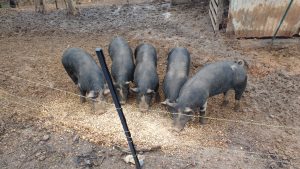
After a few days of standing close by as they eat, allowing them to become comfortable with my presence, I begin to touch the tops of their heads. At first they shy away, but after a few attempts, they let me scratch behind their ears. In time, we move on to back scratches, then belly rubs.
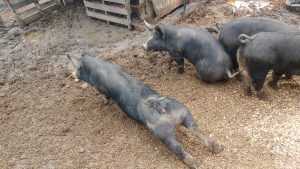
Petting piglets is a pleasure. Like puppies, they can easily get riled up and start nipping excitedly at your fingers and feet. So, I am really careful not to let this happen. Instead I focus on making them calm with my petting practices. If I am effective, they stretch out like cats do and bask in the affection. Then they flop over on their sides and expose their bellies as a sign of trust.
As much as I enjoy this bonding, it also serves other purposes. It helps if I need to inspect or treat them for health problems. Most importantly though, when their final day comes, our pigs come easily to the fence line for feed. I give them a calming pet on the head and behind the ears, as they put their heads down and eat.
They have no fear of death–not even as we take aim. And if something were to go wrong with our first shot, I can use this established pattern to lull them back to calm quickly so there is no unnecessary suffering.
Only when they are calm and quiet, and distracted by the food in front of them, do we take the shot.
Taking the Shot
When we first started processing pigs, we would stand back some distance and take our time waiting for the perfect shot. We’d seen this on videos and figured this was the best way to do it.
It worked well most of the time. But we had a couple instances of the pigs turning their heads at the last moment and the shot bouncing off their tough forehead plates. The pigs were then frightened and had to be coaxed and calmed for a long time before we could get them back in the slaughter zone. We even saw signs of stress in the meat of one of our pigs.
Now, since I take so much time to tame our pigs from the moment they arrive on our homestead, we stand just a couple feet in front of them and take the shot. This way we don’t miss.
The target for the shot is right between the ears and the eyes. If you draw an “X” in your imagination between these locations and then shoot for the center of the X, the pig will drop on its side and twitch with nervous convulsions.
We use a .22 rifle do to the job. But we suspect that at that close of a range a .22 handgun might work just as well.
Also, make sure you are not on the downhill side of the pig when you take the shot in case they roll in your direction when they drop.
Bleeding Out a Pig
The shot stuns and immobilizes the pig so that you can then use a knife to bleed the pig. You don’t want the pigs to be in pain as they die, but you do want to keep their heart beating until the last of their blood flows from their body. This makes evisceration (gutting) much easier.
There are three common techniques for bleeding out a pig.
#1: Cutting the Carotid Arteries on Each Side of the Neck
The first method is to cut the carotid arteries on each side of the neck. The arteries basically run along either side of the throat. Because we like to make jowl bacon, we try to make our cut below the jaw line closer to the clavicle. Then we use that cut as the line for decapitating the pig later.
Since the pig normally drops on one side, you can cut the artery on whichever side is facing up first. The blood will run quickly and thickly if you have cut the artery. If it doesn’t, then you know you have missed and need to cut deeper. To cut the other artery, you usually have to flip the pig to the other side and repeat the procedure.
The pig will die faster if you cut both arteries. However, depending on the size of your pig and how they fell, it’s not always easy to flip them over or get your knife in position to cut the other side. If the pig is bleeding out quickly and shows no signs of suffering, sometimes you can just cut one side and still get a quick death.
#2: Cutting Both Carotid Arteries from One Side of the Pig
To get both arteries from one side of the pig, poke your knife through both sides of the neck tissue on the stomach side of the pig. Then face the blade of your knife towards the pig’s throat and cut until you cause both arteries to gush. This is the method most of the “old-timers” (experts of a certain age) seem to use in my area.
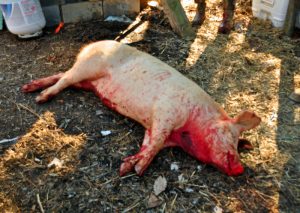
Photo Courtesy of Tim Miles
#3: Severing All of the Arteries at the Heart Junction
Alternatively, you can sever all the arteries at the juncture where they meet the top of the heart. Plunge the knife in the space between the clavicle and the neck tissue and direct your knife toward the center of the pig’s body at an angle until blood gushes. You can see a really simple diagram of the correct angle at this site: https://www.hsa.org.uk/bleeding-and-pithing/bleeding.
This method is a bit easier than cutting the carotid arteries. However, many people who use this method also tend to puncture the heart. The tissue damage and subsequent clotting can make the heart a little unappetizing if you plan to eat it.
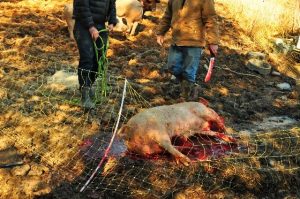
Photo Courtesy of Tim Miles
With any of these methods, when the blood begins to slow, you can lift and lower the pig’s front foot to force pump any remaining blood.
Reflection
After the blood visibly stops flowing, before we drag the pig the few feet to our scaffold area for scalding, we pause to have a moment of silence and honor our now deceased pig. We also let out a sigh of relief at giving our pig the most merciful death we were capable of.
If you are processing more than one pig, you’ll probably be pretty surprised to realize that the other pigs don’t seem at all bothered by the loss of their paddock mate. In fact, they will often come over and push the dead pig out of the way so they can eat any food and blood on the ground.
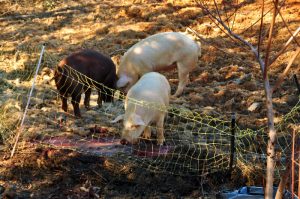
Photo Courtesy of Tim Miles
When things go well, even your last pig of the day still has no concerns about what’s coming. However if things go wrong, such as you miss a shot and one pig squeals in fear, the other pigs do notice, and are wary of you until their moment comes.
We learned this the hard way our first year of raising pigs. Now, we strive never to have our pigs know the fear of death again.
Writing this is nearly as difficult as doing the deed. I have five pigs up in the paddock now who will meet this fate just a couple of months from now. So, this seems like a good point to pause and go give them some pets and appreciate their perfect pigness while I can.
Next Up
Our next installment in this series will cover scalding and evisceration. Then, we’ll move on to butchering. And after that, we’ll get to sausage-making, ham-curing, bacon-making, and more. So, stay tuned for more posts to come!
Also, if you feel as we do and want to raise your own pigs, now is the time to start thinking about piglets.
Depending on breed maturity rates, you’ll want to get your piglets about 6-8 months before you plan to process them. Since you want fairly cool, but not freezing temperatures for processing, in many climates, most people starting thinking about getting piglets in spring time to have them ready by fall. Piglets from good breeders tend to sell out quickly, so if raising and processing pigs is on your radar for this year, start looking for your piglet source and get your reservations in early.
If you’ve managed to read this far, I’d love to hear your thoughts on raising and slaughtering pigs at home. Please use the comments section below to share your views and experiences, or to ask any questions you may have.
Also, if you’d like to read more on pig processing before we move on in the series, you can check out my earlier posts from my first time processing pigs:
Read More: “Part 1: Raising Hogs”
Read More: “Part 2: Hog Killin'”
Read More: “Part 3: Hog Cookin'”

Tasha Greer is a regular contributor to The Grow Network and has cowritten several e-books with Marjory Wildcraft. The author of “Grow Your Own Spices” (December 2020), she also blogs for MorningChores.com and Mother Earth News. For more tips on homesteading and herb and spice gardening, follow Tasha at Simplestead.com.
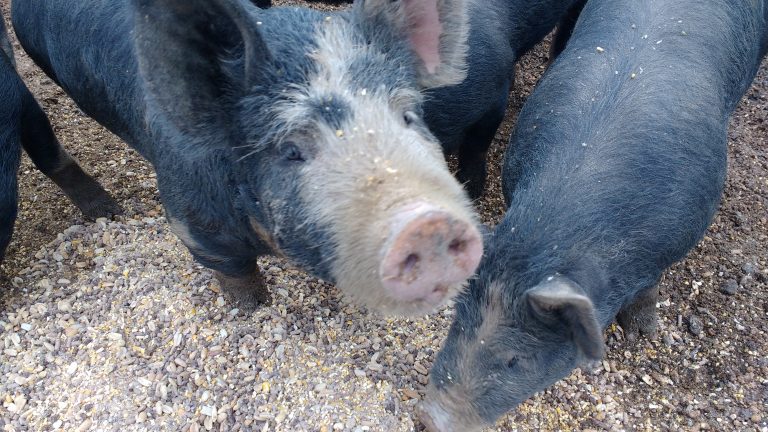








COMMENTS(16)
Thanks for the article; very interesting to me as one who has never slaughtered any animal I’ve eaten. I think that doing so would give me a very valuable, and much-needed, perspective…on many things.
Hey Niko – I don’t think I ever managed myself as someone who would slaughter animals. But, there just comes a point in your homestead journey when you realize you need to face that aspect of your food supply head on. It is definitely an insightful experience. Though never an easy one. Thanks for reading!
Or just don’t eat pigs we don’t have to eat bacon! It’s not a food group!! How horrible why was this sent to my email. What a dumb argument about “if we don’t eat pigs they will go extinct.” Are cats extinct? Are horses? We don’t need to eat pigs, there’s essentially no nutritional value in pork. Pigs are so friendly and make great pets for people who live the country. I am unsubscribing. If it pains you that much to kill a pig, the emotions you speak about in the book, then why do you do it? Ignoring your conscience? I’d rather eat plants and healthy fats.
Tracy,
I appreciate that you took the time to read and comment. I know we have very different opinions on this. But, believe me, I’ve done more research and given more consideration to this subject than I can summarize in a short blog.
For example, even just recently the Manglitsa, a lard type pig, almost went extinct because they require special diets high in vegetable matter, longer maturity times, and produce more lard than consumers generally want. In other words, they don’t work well in industrial farming.
Some estimates say there were as few as 200 of this breed left and much of the genetic diversity had already been lost. Fortunately, word got out to the culinary community and chefs and conscientious consumers created the demand that kept this breed from becoming extinct. Mangalitsa populations and genetic diversity are now on the rise.
Also, with respects to cats (and dogs, too), quite a bit of the available food on the market actually contains pork products even if they aren’t on the label. Many of our other domesticated animals are dependent on the meat industry for their food supply. It’s hard to imagine a world with out cats and dogs, but unfortunately, whether we like it or not, their lives are linked to those of our other domesticated livestock by way their dependence on that source of food.
I totally respect people who can live without dependence on livestock or who can afford to raise them as pets for their full lifespans. Personally, I can’t afford to keep these animals purely as pets and I find it very difficult to run a mostly self-sufficient homestead without their inputs. So I try to make the most conscientious decisions I can.
I really do appreciate your perspective. And I sincerely hope that you won’t leave The Grow community over one blogger’s opinions. This is a big community with a lot of diverse ideas.
Thank you again for taking the time to read and comment.
Thank you for sharing your method of humanely raising pigs for food. I have been thinking about adding pigs to our small farm, but there is much research to be done. I have a question about the actual shooting part. Do you separate the pigs so there is only one there at the time of the shooting or are they all there in a ‘pack’ ?(not sure of the proper name for a bunch of pigs together). Are you shooting to process only one at a time or more than one? (I would think one alone would be a huge job). Thanks.
Hey Kate – Pigs are competitive about eating. So it would be really hard to separate them entirely. Even if you put the feed in several locations, they’ll all eat in one location, finish it, then move on the next. We do pour the feed in a long line though and nudge them apart to make sure we can get a clean shot.
It’s pretty surprising that they don’t even react when their herd mate goes down. They just keep right on eating.
We process one at a time. But if we are doing it as a multi-day process, we never leave a pig alone over night. They really are social creatures and I wouldn’t want them to be lonely even for a short period of time.
It’s a big undertaking. It also makes you feel extremely capable though when you do manage it. I always feel as if I am doing all the farmers in my family history proud when things go well.
Good luck!
I agree 100% with Tracy and her comments, above. There is no need to slaughter innocent animals, including pigs. If I had known this was about killing/slaughtering animals for food, I never would have subscribed to this list, so I am about to unsubscribe! I have observed throughout my long life that people who eat meat are heartless and mean to others, including and most especially animals. My own sister and her husband raised and slaughtered their own cattle on their ranch here in Texas, and now he is dead from heart failure and she is in poor health. Both of them are/were pretty mean people, not only to their own kids, but to others as well, including their own “pet” cats that they never fed and left behind when they sold their ranch. They often criticized me for not wanting to eat beef or other meat products, and I just stood my ground. I am vegan and trying for raw vegan soon. You people should be ashamed of yourselves for murdering and consuming harmless animals and for duping people into believing this is all about growing your own vegetables! Ha! Your life spans will never be as long as those who don’t consume animal products, I promise you. I am so glad to opt out of this. You had me and I’m sure many others fooled into thinking this was all about growing your own veggies. Shame on you!!!
Adrienne in Texas
From what you say, it looks like your own sister and her husband, in the end, suffered some “payback” from what they did to the cattle they raised. Ain’t Karma a bitch! BTW, Karma NEVER forgets and NEVER forgives. You pay for what you DO regardless of what is “legal” and “socially” acceptable.
Adrienne – I really appreciate your comments.
I think it’s difficult to make blanket statements about people’s character based on a single choice – such as whether they eat meat, raise meat, or not. I know some wonderful people who raise meat, who eat meat, who are vegetarians, and who are vegans. I also know some people in all of these categories who have a lot of anger and tend to hurt themselves and others as a result.
Making good food choices is complicated no matter what you eat. There are so many fossil fuels and so much environmental harm in everything at the grocery store. There are also so many compromises even in how we treat the workers who grow and harvest food for us and our planet even if we don’t eat meat.
The closer you can get to your food supply, either by growing it yourself or knowing your farmers, the more control you have over the impact your food choices have over others. I think that’s what TGN is really about for me – getting us all closer to our food supplies by sharing information and connecting us with a community of people focused on growing or knowing about their food and medicine.
There’s plenty of great information in this community on growing vegetables. And whether or not this is the right community for you, I hope that you reach your goal of becoming raw vegan and enjoy all the health benefits of eating a plant-based diet.
Thank you again for commenting.
Do you and your friends ever thank the animal you are about to eat for “sacrificing” THEIR life in order that you may live? From what I understand about various Native American tribes and their customs, they say a prayer of thanksgiving to the animals they eat.
No. The animal doesn’t understand the vernacular being spoken. But they understand the spirit of what is spoken. That’s what really counts as opposed to the prayers of rote that are spoken by the hypocrites of the world.
Sacrifice is actually the perfect word for the way I think of this. And so I really try to understand and appreciate the sacred in our animals, and my sacred responsibilities to them as their caretaker and co-dependent. I wasn’t raised with Native American traditions, but I really agree with their ideas that all life is sacred especially those that are sacrificed so that others may live.
I think intentions and emotions communicate a lot when working with animals – much more than words. Thank you for bringing this idea to the conversation. Tasha
I have to say to sit in judgement of those who choose to eat meat is pretty pathetic. Also there was a “warning or disclaimer” on the email stating exactly what this was about so stop whining about that. If you didn’t want to see it or read it, you shouldn’t have. I think this is very valuable information and if you have ever seen a large, commercial farm, you would see this is a much better, more humane way of butchering. Grow up people and stop judging other’s life choices.
Amy – Thanks for sounding in. These issues are complicated and we all have to make our own decisions about what seems right to us. I agree with you on the judgement side of things, I think there’s room for people to make different decisions and for us all to respect each other.
I know when I put this information out there that some people won’t agree. But, I think it’s important to share so we can keep progressing towards something better. I don’t like the way pigs are treated in industrial environments. But, even on the commercial side, there are things they do a lot better than we do on the homestead. For example, they use more of the animal than we can with our tool and time limitations. Also, things like insulin for insulin-dependent diabetics come from industrial pig processing. So we have to figure that out too.
I am with you though. Less judging, more learning, and maybe we’ll get closer to better all around answers. Thanks for your input!
Thanks for the info! When we started homesteading I also had that ‘almost spiritual’ experience with our first animal that we slaughtered ourselves (it was a sheep). Since that time I have felt that if someone chooses to eat meat, then they should be prepared to slaughter themselves. I now only buy meat from a local small farmer, who slaughters himself. The animals know no fear, and do have the best life possible.
Thank you for tackling this sensitive subject in a tactful and kind way.
Great picture! We have also raised some pigs for our family members. But they know they have to participate in the processing. So even though we do most of the daily work, they still understand the real price of meat – as in the life of the animal. I do think having that kind of understanding changes you. Thank you for sharing your experience. It’s so important!
Thank you, Tasha, for the article, and for your sensitive and kind treatment of pigs and of comments. It is a needed skill, and you enable one to better raise and harvest pigs, while being appreciative of them and respectful. Letting them enjoy their life and have a respectful and painless end. It is more challenging to face a grown feral boar that invades the homestead but even in this case doing it with a good dog partner and training in hunting, it demands we harvest the difficult subject with with respect–a prayer of thanks, and not waste it.